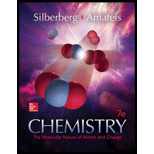
Concept explainers
(a)
Interpretation:
The conversion factor to convert
Concept introduction:
The conversion factor is the ratio or fraction that represents the relationship between the two units. Let us suppose the temperature in
The unit with which the conversion is to be started should be written in the denominator so that it can cancel out the given unit. The desired unit to which the given unit is to be converted should be written in the numerator so that the required conversion can be done.
(b)
Interpretation:
The conversion factor to convert
Concept introduction:
The conversion factor is the ratio or fraction that represents the relationship between the two units. Let us suppose the temperature in
The unit with which the conversion is to be started should be written in the denominator so that it can cancel out the given unit. The desired unit to which the given unit is to be converted should be written in the numerator so that the required conversion can be done.
(c)
Interpretation:
The conversion factor to convert
Concept introduction:
The conversion factor is the ratio or fraction that represents the relationship between the two units. Let us suppose the temperature in
The unit with which the conversion is to be started should be written in the denominator so that it can cancel out the given unit. The desired unit to which the given unit is to be converted should be written in the numerator so that the required conversion can be done.
(d)
Interpretation:
The conversion factor to convert
Concept introduction:
The conversion factor is the ratio or fraction that represents the relationship between the two units. Let us suppose the temperature in
The unit with which the conversion is to be started should be written in the denominator so that it can cancel out the given unit. The desired unit to which the given unit is to be converted should be written in the numerator so that the required conversion can be done.
Want to see the full answer?
Check out a sample textbook solution
Chapter 1 Solutions
Chemistry: The Molecular Nature of Matter and Change - Standalone book
- Draw the products of this reduction of a ketone with sodium borohydride. Use a dash or wedge bond to indicate the stereochemistry of substituents on asymmetric centers, where applicableIgnore any inorganic byproducts. 1) NaBH4 2) HCI/H2O Select to Drawarrow_forwardWhy do you think people who live at high altitudes are advised to add salt to water when boiling food like pasta? What mole fraction of NaCl is needed to raise the boiling point of H2O by 3˚C? Does the amount of salt added to water (typically about one teaspoon to four quarts of water) substantially change the boiling point? (Kb (H2O) = 0.51˚C/molal.)arrow_forwardpls help asaparrow_forward
- pls help asaparrow_forward9. Consider the following galvanic cell: Fe (s) | Fe(NO3)2 (aq) || Sn(NO3)2 (aq) | Sn (s) a. Write an equation for the half reactions occurring at the anode and cathode. b. Calculate the standard cell potential Show all of your work. c. Draw and label the galvanic cell, including the anode and cathode, direction of electron flow, and direction of ion migration.arrow_forwardpls help asaparrow_forward
- 11. Use the equation below to answer the following questions: 2 Al(s) + 3 Cd(NO3)2 (aq) → 2 Al(NO3)3 (aq) + 3 Cd(s) a. What is the net ionic equation for the reaction? b. Which species is a spectator ion in this reaction? Define a spectator ion. c. Identify the oxidizing agent and the reducing agent.arrow_forwardpls help asaparrow_forwardpls help asaparrow_forward
 ChemistryChemistryISBN:9781305957404Author:Steven S. Zumdahl, Susan A. Zumdahl, Donald J. DeCostePublisher:Cengage Learning
ChemistryChemistryISBN:9781305957404Author:Steven S. Zumdahl, Susan A. Zumdahl, Donald J. DeCostePublisher:Cengage Learning ChemistryChemistryISBN:9781259911156Author:Raymond Chang Dr., Jason Overby ProfessorPublisher:McGraw-Hill Education
ChemistryChemistryISBN:9781259911156Author:Raymond Chang Dr., Jason Overby ProfessorPublisher:McGraw-Hill Education Principles of Instrumental AnalysisChemistryISBN:9781305577213Author:Douglas A. Skoog, F. James Holler, Stanley R. CrouchPublisher:Cengage Learning
Principles of Instrumental AnalysisChemistryISBN:9781305577213Author:Douglas A. Skoog, F. James Holler, Stanley R. CrouchPublisher:Cengage Learning Organic ChemistryChemistryISBN:9780078021558Author:Janice Gorzynski Smith Dr.Publisher:McGraw-Hill Education
Organic ChemistryChemistryISBN:9780078021558Author:Janice Gorzynski Smith Dr.Publisher:McGraw-Hill Education Chemistry: Principles and ReactionsChemistryISBN:9781305079373Author:William L. Masterton, Cecile N. HurleyPublisher:Cengage Learning
Chemistry: Principles and ReactionsChemistryISBN:9781305079373Author:William L. Masterton, Cecile N. HurleyPublisher:Cengage Learning Elementary Principles of Chemical Processes, Bind...ChemistryISBN:9781118431221Author:Richard M. Felder, Ronald W. Rousseau, Lisa G. BullardPublisher:WILEY
Elementary Principles of Chemical Processes, Bind...ChemistryISBN:9781118431221Author:Richard M. Felder, Ronald W. Rousseau, Lisa G. BullardPublisher:WILEY





